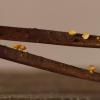
24-12-2025 17:08
Hulda Caroline HolteHello, I have found this propoloid ascomycete on

21-12-2025 09:32
Hello.A tiny ascomycete found embedded in wood in

21-12-2025 21:32
Pol DebaenstHello, Garden, Burgweg 19, Veurne, BelgiumOn 10/1

22-12-2025 23:38
Patrice TANCHAUDBonsoir, récolte sur un mur en pierre, apothéci

22-12-2025 00:47
Patrice TANCHAUDBonsoir, récolte à proximité du milieu dunaire
Antinoa pulchella?
Edvin Johannesen,
20-03-2023 19:25
 Hi!
Hi!Can Antinoa pulchella be this yellow on the outside (excipulum) and stipe? Growing of Pinus sylvestris needles. A very preliminary microscopic study shows asci ca. 30 x 4 micr. and spores ca. 5-6 x 1-1.5 micr., ellipsoid-fusiform, somewhat narrower at one end. I am of course ready to do further studies, if necessary, but difficult to take good photos. Bright yellow pigment seen in excipulum. Thanks.
Hans-Otto Baral,
20-03-2023 21:28

Re : Antinoa pulchella?
I am quite convinced it is. I know it with longer, more slender stalk but in my folder are also such like yours. In one collection (1.XI.2019) I see hair-like elements almost like in Hyaloscypha, in others more cylindrical and not tapering. I am not sure how A. acuum can safely be delimited.
Edvin Johannesen,
20-03-2023 22:10

Re : Antinoa pulchella?
Thanks a lot! Yes, I did see your 1.XI.2019 photos before I posted, which gave me hope that this could be A. pulchella. I see the same yellow "hair-like" structures in some of our apos, especially the smaller ones. Second find in Norway (previous reported as Pezizella pulchella).
